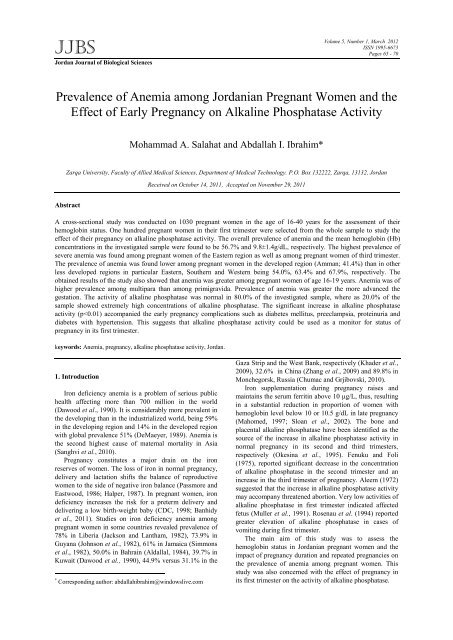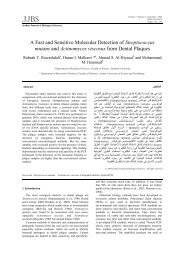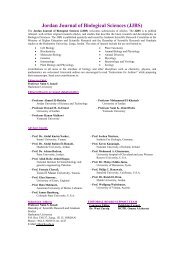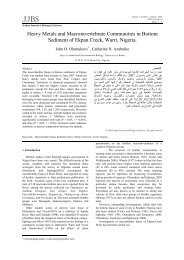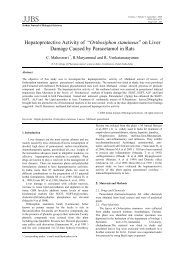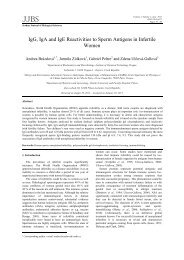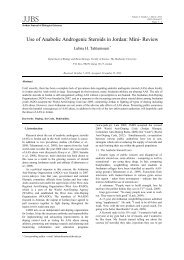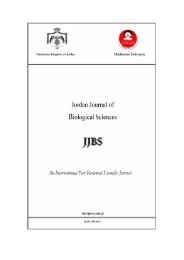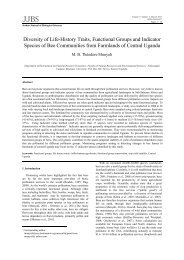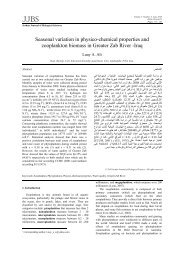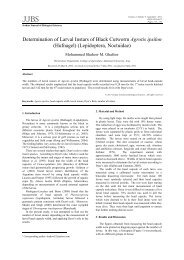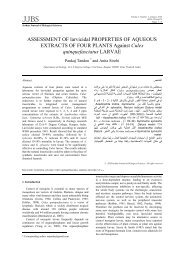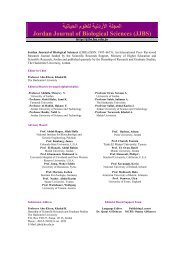Prevalence of Anemia among Jordanian Pregnant Women and the ...
Prevalence of Anemia among Jordanian Pregnant Women and the ...
Prevalence of Anemia among Jordanian Pregnant Women and the ...
Create successful ePaper yourself
Turn your PDF publications into a flip-book with our unique Google optimized e-Paper software.
JJBS<br />
Jordan Journal <strong>of</strong> Biological Sciences<br />
Volume 5, Number 1, March 2012<br />
ISSN 1995-6673<br />
Pages 65 - 70<br />
<strong>Prevalence</strong> <strong>of</strong> <strong>Anemia</strong> <strong>among</strong> <strong>Jordanian</strong> <strong>Pregnant</strong> <strong>Women</strong> <strong>and</strong> <strong>the</strong><br />
Effect <strong>of</strong> Early Pregnancy on Alkaline Phosphatase Activity<br />
Mohammad A. Salahat <strong>and</strong> Abdallah I. Ibrahim*<br />
Zarqa University, Faculty <strong>of</strong> Allied Medical Sciences, Department <strong>of</strong> Medical Technology. P.O. Box 132222, Zarqa, 13132, Jordan<br />
Abstract<br />
Received on October 14, 2011, Accepted on November 29, 2011<br />
A cross-sectional study was conducted on 1030 pregnant women in <strong>the</strong> age <strong>of</strong> 16-40 years for <strong>the</strong> assessment <strong>of</strong> <strong>the</strong>ir<br />
hemoglobin status. One hundred pregnant women in <strong>the</strong>ir first trimester were selected from <strong>the</strong> whole sample to study <strong>the</strong><br />
effect <strong>of</strong> <strong>the</strong>ir pregnancy on alkaline phosphatase activity. The overall prevalence <strong>of</strong> anemia <strong>and</strong> <strong>the</strong> mean hemoglobin (Hb)<br />
concentrations in <strong>the</strong> investigated sample were found to be 56.7% <strong>and</strong> 9.8±1.4g/dL, respectively. The highest prevalence <strong>of</strong><br />
severe anemia was found <strong>among</strong> pregnant women <strong>of</strong> <strong>the</strong> Eastern region as well as <strong>among</strong> pregnant women <strong>of</strong> third trimester.<br />
The prevalence <strong>of</strong> anemia was found lower <strong>among</strong> pregnant women in <strong>the</strong> developed region (Amman; 41.4%) than in o<strong>the</strong>r<br />
less developed regions in particular Eastern, Sou<strong>the</strong>rn <strong>and</strong> Western being 54.0%, 63.4% <strong>and</strong> 67.9%, respectively. The<br />
obtained results <strong>of</strong> <strong>the</strong> study also showed that anemia was greater <strong>among</strong> pregnant women <strong>of</strong> age 16-19 years. <strong>Anemia</strong> was <strong>of</strong><br />
higher prevalence <strong>among</strong> multipara than <strong>among</strong> primigravida. <strong>Prevalence</strong> <strong>of</strong> anemia was greater <strong>the</strong> more advanced <strong>the</strong><br />
gestation. The activity <strong>of</strong> alkaline phosphatase was normal in 80.0% <strong>of</strong> <strong>the</strong> investigated sample, where as 20.0% <strong>of</strong> <strong>the</strong><br />
sample showed extremely high concentrations <strong>of</strong> alkaline phosphatase. The significant increase in alkaline phosphatase<br />
activity (p
66<br />
2. Materials <strong>and</strong> Methods<br />
2.1. The Sample<br />
© 2012 Jordan Journal <strong>of</strong> Biological Sciences. All rights reserved - Volume 5, Number 1<br />
A representative sample <strong>of</strong> 1030 pregnant women in<br />
<strong>the</strong> age <strong>of</strong> 16-40 years was r<strong>and</strong>omly selected from four<br />
health regions <strong>of</strong> <strong>the</strong> country.<br />
2.2. Technique<br />
2.2.1. Collected data <strong>and</strong> blood samples<br />
A questionnaire was completed for each pregnant<br />
investigated woman <strong>and</strong> <strong>the</strong> following data was collected:<br />
• Age at pregnancy<br />
• Duration <strong>of</strong> present pregnancy<br />
• Total number <strong>of</strong> pregnancies Every woman<br />
investigated was requested to <strong>of</strong>fer a finger prick<br />
capillary blood sample.<br />
2.2.2. Determination <strong>of</strong> hemoglobin (Hb) concentration<br />
Assessment <strong>of</strong> hemoglobin concentration was carried<br />
out by cyanme<strong>the</strong>moglobin technique (Makarem, 1974).<br />
2.2.3. Cut-<strong>of</strong>f level <strong>of</strong> anemia<br />
The World Health Organization (1972) cut-<strong>of</strong>f level for<br />
diagnosis <strong>of</strong> anemia <strong>among</strong> pregnant women was used in<br />
<strong>the</strong> present study.<br />
<strong>Anemia</strong> was categorized into three classes <strong>of</strong> severity:<br />
- Severe: Hb. concentration < 8.0 g/dL<br />
- Moderate: Hb. Concentration 8.0-9.0 g/dL<br />
- Mild: Hb. concentration 9.0-10.9 g/dL<br />
Region<br />
Amman<br />
(Capital)<br />
2.2.4. Determination <strong>of</strong> alkaline phosphatase activity<br />
Blood samples were collected from 100 pregnant<br />
women in <strong>the</strong>ir first trimester. The serum was separated<br />
from each blood sample upon centrifugation at 2500 rpm<br />
for 10 minutes. Alkaline phosphatase activity was<br />
determined according to <strong>the</strong> procedure <strong>of</strong> American<br />
Association for clinical chemistry (Tietz, 1983). The<br />
reference range <strong>of</strong> alkaline phosphatase activity was 26.0-<br />
99.0 UIL at 30°C.<br />
2.2.5. Statistical Analysis<br />
All <strong>the</strong> statistical analyses were performed using <strong>the</strong><br />
student t test.<br />
3. Results<br />
Table 1 shows <strong>the</strong> prevalence <strong>of</strong> anemia <strong>and</strong> <strong>the</strong> mean<br />
hemoglobin concentrations <strong>among</strong> <strong>Jordanian</strong> pregnant<br />
women in different regions <strong>of</strong> <strong>the</strong> country. The lowest<br />
prevalence was observed in <strong>the</strong> capital Amman (41.4%;<br />
mean Hb concentrations 11.4 ± 1.2 g/dL) <strong>and</strong> become<br />
higher in <strong>the</strong> Eastern (54.0%; mean Hb concentrations 9.5<br />
± 1.4 g/dL), Sou<strong>the</strong>rn (63.4%; mean Hb concentrations 9.1<br />
± 1.5 g/dL), <strong>and</strong> Western (67.9%; mean Hb concentrations<br />
9.3 ± 1.3 g/dL). The differences were found to be<br />
statistically significant (P
Pregnancy<br />
Duration<br />
© 2012 Jordan Journal <strong>of</strong> Biological Sciences. All rights reserved - Volume 5, Number 1<br />
Table 2. <strong>Prevalence</strong> <strong>of</strong> <strong>Anemia</strong> <strong>among</strong> <strong>Pregnant</strong> women by duration <strong>of</strong> pregnancy<br />
Anemic (%)<br />
Severe Moderate Mild Total<br />
Non-Anemic (%)<br />
Hb (Mean ± SD)<br />
(g/dL)<br />
First Trimester 0.3 7.2 39.5 47.0 53.0 11.0 ± 1.6 305<br />
Second<br />
Trimester<br />
No. <strong>of</strong><br />
Sample<br />
2.1 9.6 44.4 56.1 43.9 10.1 ± 1.3 515<br />
Third Trimester 3.2 12.6 51.1 66.9 33.1 8.7 ± 1.4 210<br />
Mean 1.86 9.8 45.0 56.7 43.3 9.9 ± 1.4<br />
Total 1030<br />
The prevalence <strong>of</strong> anemia <strong>among</strong> pregnant women <strong>and</strong><br />
mean hemoglobin concentrations by <strong>the</strong> number <strong>of</strong><br />
pregnancies are shown in table 3. A statistically different<br />
increase (P
68<br />
No. <strong>of</strong><br />
Sample<br />
4. Discussion<br />
© 2012 Jordan Journal <strong>of</strong> Biological Sciences. All rights reserved - Volume 5, Number 1<br />
Table 5. Mean Alkaline Phosphatase Activity in Different Types <strong>of</strong> Early Pregnancy Complications<br />
Complications (%)<br />
Alkaline Phosphatase Activity (Mean ± SD)<br />
(U/L)<br />
7 Diabetes Mellitus 7 125.0 ± 8.5<br />
3 Pre-eclampsia 3 172.3 ± 8.1<br />
4 Proteinuria 4 155.5 ± 11.2<br />
6 Diabetes Mellitus <strong>and</strong> Hypertension 6 131.7 ± 7.4<br />
80 No complication 80 78.3 ± 12.5<br />
The lowest prevalence <strong>of</strong> anemia <strong>among</strong> <strong>Jordanian</strong><br />
pregnant women was observed in <strong>the</strong> capital Amman<br />
(41.4%; mean Hb concentrations 11.4 ± 1.2 g/dL), while it<br />
was higher in <strong>the</strong> Eastern (54.0%; mean Hb concentrations<br />
9.5 ± 1.4 g/dL), Sou<strong>the</strong>rn (63.4%; mean Hb concentrations<br />
9.1 ± 1.5 g/dL), <strong>and</strong> Western (67.9%; mean Hb<br />
concentrations 9.3 ± 1.3 g/dL). These differences were<br />
statistically significant (P
Acknowledgment<br />
© 2012 Jordan Journal <strong>of</strong> Biological Sciences. All rights reserved - Volume 5, Number 1<br />
This research is funded by <strong>the</strong> Deanship <strong>of</strong> Research<br />
<strong>and</strong> Graduate Studies in Zarqa University, Jordan. The<br />
authors would like to express <strong>the</strong>ir thanks to Suhail Ahmed<br />
<strong>and</strong> Saed Shaker for <strong>the</strong>ir assistance in conducting this<br />
study. We wish to express our thanks to Pr<strong>of</strong>. Sami Khaled<br />
for his guidance <strong>and</strong> assistance. We also appreciate <strong>the</strong><br />
statistical assistance <strong>of</strong>fered by <strong>the</strong> Data Processing <strong>and</strong><br />
Computer Section <strong>of</strong> <strong>the</strong> Computer Technical Company.<br />
References<br />
[1] Aldallal ZS. 1984. Some demographic <strong>and</strong> health information<br />
about mo<strong>the</strong>rs in Bahrain. In: AO Musaiger. Studies on<br />
nutrition in Bahrain. Nutrition Unit, Public Health<br />
Directorate, Ministry <strong>of</strong> Public Health, Bahrain. p. 11-12.<br />
[2] Aleem FA. 1972. Total <strong>and</strong> heat-stable serum alkaline<br />
phosphatase in normal <strong>and</strong> abnormal pregnancies. Obstet<br />
Gynecol, 40:163-172.<br />
[3] Al-Farsi YM, Brooks DR, Werler MM, Cabral HJ, Al-Shafei<br />
MA <strong>and</strong> Wallenberg HC. 2011. Effect <strong>of</strong> high parity on<br />
occurrence <strong>of</strong> anemia in pregnancy: a cohort study. BMC<br />
Pregnancy <strong>and</strong> Childbirth, 11:7-13.<br />
[4] Banerjee B, P<strong>and</strong>ey GK, Dutt D, Sengupta B, Mondal M <strong>and</strong><br />
Deb S. 2009. Teenage pregnancy: A socially inflicted health<br />
hazard. Indian J. <strong>of</strong> Community Medicine, 34: 227-231.<br />
[5] Banhidy F, Acs N, Puho EH <strong>and</strong> Czeizel AE. 2011. Iron<br />
deficiency anemia: Pregnancy outcomes with or without iron<br />
supplementation. Nutrition, 27: 65-72.<br />
[6] Bashiri A, Katz O, Maor E, Sheiner E, Pack I <strong>and</strong> Mazor M.<br />
2007. Positive placental staining for alkaline phosphatase<br />
corresponding with extreme elevation <strong>of</strong> serum alkaline<br />
phosphatase during pregnancy. Arch Gynecol Obstet, 275:<br />
211-214.<br />
[7] Centers for Disease Control <strong>and</strong> prevention (CDC). 1998.<br />
Recommendations to prevent <strong>and</strong> control iron deficiency in<br />
<strong>the</strong> United States. MMWR Morb Mortal Wkly Rep, 3: 1-29.<br />
[8] Charles AM, Campbell-Stennett D, Yatich N <strong>and</strong> Jolly PE.<br />
2010. Predictors <strong>of</strong> anemia <strong>among</strong> pregnant women in<br />
Westmorel<strong>and</strong>, Jamaica. Health Care for <strong>Women</strong><br />
International, 31: 585-598.<br />
[9] Chumak EL <strong>and</strong> Grjibovski AM. 2010. <strong>Anemia</strong> in pregnancy<br />
<strong>and</strong> its association with pregnancy outcomes in <strong>the</strong> Arctic<br />
Russian town <strong>of</strong> Monchegorsk, 1973-2002. Int J<br />
Circumpolar Health, 69: 265-277.<br />
[10] Dawood HS, Prakash P <strong>and</strong> Shubber KMR. 1990. Iron<br />
deficiency anemia <strong>among</strong> <strong>Pregnant</strong> Arab <strong>Women</strong> in Kuwait.<br />
The J. <strong>of</strong> Kuwait Medical Association, 24: 167-172.<br />
[11] DeMaeyer EM. 1989. Preventing <strong>and</strong> Controlling Iron<br />
Deficiency <strong>Anemia</strong> through Primary Health Care. World<br />
Health Organization, Geneva.<br />
[12] Fenuku RI <strong>and</strong> Foli AK. 1975. Serum alkaline phosphatase<br />
activity during pregnancy <strong>and</strong> <strong>the</strong> post-partum period in<br />
Ghanaian women. Trop Geogr Med, 27: 371-374.<br />
[13] Gharaibeh M, Al-Ma’aiteh R <strong>and</strong> Al Jada N. 2005. Lifestyle<br />
practices <strong>of</strong> <strong>Jordanian</strong> pregnant women. International<br />
Nursing Review, 52: 92-100.<br />
[14] Grgic G <strong>and</strong> Bogdanovic G. 2009. Placental alkaline<br />
phosphatase in <strong>the</strong> prediction <strong>of</strong> preterm delivery. Acta<br />
Medica Academica, 38: 16-20.<br />
[15] Halper SL. 1987. Quick Reference to Clinical Nutrition,<br />
Second ed. J.B. Lippincott Co., Philadelphia.<br />
[16] Jackson RT <strong>and</strong> Lantham MC. 1982. <strong>Anemia</strong>s <strong>of</strong> Pregnancy<br />
in Liberia. Am J Clin Nut, 35: 710-714.<br />
[17] Jamjute P, Ahmad A, Ghosh T <strong>and</strong> Banfield P. 2009. Liver<br />
function test <strong>and</strong> pregnancy. The J for Maternal-Fetal <strong>and</strong><br />
Neonatal Medicine, 22: 274-283.<br />
[18] Johnson AA, Lantham MC <strong>and</strong> Roe DA. 1982. The<br />
prevalence <strong>and</strong> etiology <strong>of</strong> anemia in Guyana. Am J Clin Nut,<br />
35: 309-318.<br />
[19] Khader A, Madi H, Ricardo F <strong>and</strong> Sabatinelli G. 2009.<br />
<strong>Anemia</strong> <strong>among</strong> pregnant Palestinian women in <strong>the</strong> occupied<br />
Palestinian territory. Public Health Nutr, 12: 2416-2420.<br />
[20] Kilbride J, Baker TG, Parapia LA <strong>and</strong> Koury SA. 2000. Iron<br />
status, serum folate <strong>and</strong> B(12) values in pregnancy <strong>and</strong><br />
postpartum: Report from a study in Jordan. Ann Saudi Med,<br />
20: 371-376.<br />
[21] Mahomed K. 1997. Routine iron supplementation during<br />
pregnancy. The Cockrane Library 285-291.<br />
[22] Makarem A. 1974. Clinical chemistry-Principles <strong>and</strong><br />
techniques, 2 nd ed. In: Henry RF, Cannon DC, Winkelman<br />
SW( Eeds.), Harper <strong>and</strong> Row, Hagerstown MD. p. 1128-<br />
1135.<br />
[23] Mirzaie F, Eftekhari N, Goldozeian S <strong>and</strong> Mahdavinia J.<br />
2010. <strong>Prevalence</strong> <strong>of</strong> anemia risk factors in pregnant women<br />
in Kerman, Iran. Iranian J <strong>of</strong> Reproductive Medicine, 8: 66-<br />
69.<br />
[24] Muller F, Oury JF, Bussiere P, Lewin F <strong>and</strong> Boue S. 1991.<br />
First-trimester diagnosis <strong>of</strong> hypophosphatasia. Importance <strong>of</strong><br />
gestational age <strong>and</strong> purity <strong>of</strong> CV samples. Prenat Diagn, 11:<br />
725-730.<br />
[25] Okesina AB , Donaldson D, Lascelles PT <strong>and</strong> Morris P.<br />
1995. Effect <strong>of</strong> gestational age on levels <strong>of</strong> serum alkaline<br />
phosphatase isoenzymes in healthy pregnant women. mt S<br />
Gynaecol Obstet, 48: 25-29.<br />
[26] Passmore R <strong>and</strong> Eastwood MA. 1986. Davidson <strong>and</strong><br />
Passmore Human Nutrition <strong>and</strong> Dietetics, 8 th ed. Churchill<br />
Living Stone, Edinburgh.<br />
[27] Rosenau L, Douay 0, Morel B, Lebouvier B <strong>and</strong> Grosieux P.<br />
1994. Serum alkaline phosphatase levels in pregnancy. J<br />
Gynecol Obstet Bio Reprod, 23: 175-179.<br />
[28] Sanghvi TG, Harvey PWJ <strong>and</strong> Wainwright E. 2010. Maternal<br />
iron-folic acid supplementation programs: Evidence <strong>of</strong><br />
impact <strong>and</strong> implementation. Food <strong>and</strong> Nutrition Bulletin,<br />
31(2): S100-S107.<br />
69
70<br />
© 2012 Jordan Journal <strong>of</strong> Biological Sciences. All rights reserved - Volume 5, Number 1<br />
[29] Simmons WK , Justum PJ <strong>and</strong> Fox K. 1982. A survey <strong>of</strong> <strong>the</strong><br />
anemia status <strong>of</strong> pre-school age children <strong>and</strong> pregnant-acting<br />
women in Jamaica. Am J din Nut, 35: 319-326.<br />
[30] Sloan N, Jordan E <strong>and</strong> Winik<strong>of</strong>f B. 2002. Effects <strong>of</strong> iron<br />
supplementation on maternal hematologic status in<br />
pregnancy. American J <strong>of</strong> Public Health, 92: 288-293.<br />
[31] Taseer I, Safdar S, Mirbahar A <strong>and</strong> Awan Z. 2011. <strong>Anemia</strong> in<br />
pregnancy: Related risk factors in under developed area.<br />
Pr<strong>of</strong>essional Med J, 18: 1-4.<br />
[32] Tietz NW. 1983. A reference method for measurement <strong>of</strong><br />
alkaline phosphatase activity in human serum. Study group<br />
on alkaline phosphatase. Clin Chem, 29:751-755.<br />
[33] World Health Organization 1972. Nutrition <strong>Anemia</strong>s. WHO<br />
technical report series, No. 503. p. 43-89.<br />
[34] Zhang Q, Li Z <strong>and</strong> Ananth CV. 2009. <strong>Prevalence</strong> <strong>and</strong> risk<br />
factors for anemia in pregnant women: a population-based<br />
prospective cohort study in China. Paediatric <strong>and</strong> Perinatal<br />
Epidemiology, 23: 282-291.


